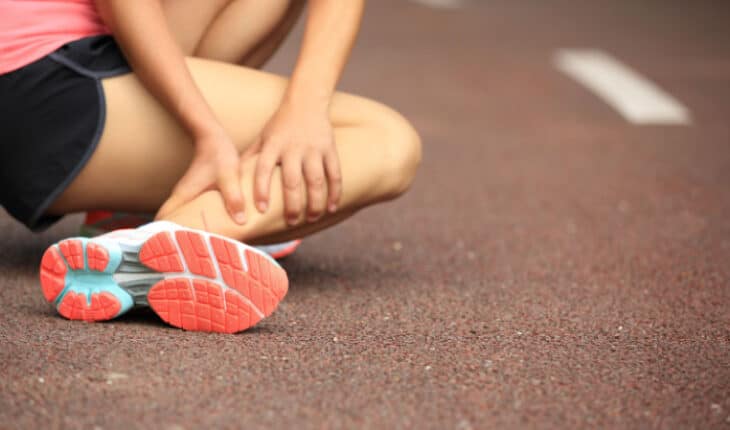This article covers some of the most common accidents and injuries that can occur when exercising. We give clear advice on injury prevention, how to recognise that an injury may have occurred and first aid advice to avoid it worsening.
It is really important to recognise quickly if you have experienced an injury, stop and give yourself time to rest and recover.
If you have any pre-existing medical condition, always get medical advice before increasing your exercise levels. Also ensure the exercise you are proposing is not contra-indicated in anyway by your condition.
Want to know more on the topic? Read How to Stay Safe on Sport Days
Always ensure you warm up before exercising
Many injuries occur purely because of taking short cuts and failing to warm up. Never start vigorously exercising without first warming and stretching your muscles. Otherwise, it is extremely common to end up with strains, sprains and ‘pulled muscles’.
If you haven’t exercised for a while, be realistic and build up the extent of your activity, slowly and steadily.
It may be sensible to invest in a heart monitoring device. You will be able to ensure you are not over-exerting yourself. If you feel unwell at any point when exercising, slow down or stop and give yourself time to recover.
The American Academy of Orthopaedic Surgeons state that strains and sprains are the most common causes of reported exercise injuries – particularly in the joints and back. Our backs are becoming weaker due to sitting too long at computers and poor posture. It is important to warm up thoroughly and exercise in a manner that does not put additional strain on our backs and other muscles.
Correct clothing for the exercise you have chosen and for the weather:
UK weather can be temperamental. If exercising outside, ensure you have appropriate layers for all eventualities.
Dress for comfort, temperature and prevention of friction injuries (such as chafing).
Ensure you have appropriate, comfortable clothing for whatever exercise you have opted for. If unsure as to what you need, check with the class organiser, your personal trainer, or look online for advice from an overseeing organisation.
Remember, whilst you’re running or exercising, you’ll be warm. However, as soon as you stop, you’ll cool down quickly. Ensure you have additional clothes to put on for when you finish.
Footwear:
Avoid lengthy runs or exercise in new trainers. Wear them in at home – your feet must be comfortable and familiar with the shoes. Also make sure that the socks you choose are comfortable and fit well. In case there is rain forecast or roads are wet if you are running, ensure your shoes have sufficient grip.
If you are walking to an exercise class in your trainers, ensure they are not wet and slippery when you start the class.
Nipple bleeding and chafing:
If you are prone to chafing when running, apply petroleum jelly or anti chafing talc. It may be helpful to cover your nipples with plasters, if they bleed when training; wash and dry them carefully and then cover with a breathable plaster. Sometimes, nipple bleeding may be due to more serious problems. If in doubt, consult your doctor.
Blisters:
If you get a blister and the skin is still intact, do not be tempted to pop it. Cover with a proper blister plaster and ensure there are no wrinkles in socks that are contributing to the rubbing.
If the blister is broken or likely to break; cover with a clean, dry, non-adhesive dressing that extends well beyond the edges of the blister. Alternatively apply a blister plaster.
To avoid blisters, ensure you are wearing shoes that are worn in and comfortable. If you need any plasters or help during the race, stop at one of the many first aid points – they should have plasters available.
Remain hydrated, but don’t drink too much:
You need to drink sufficient amounts of fluid to stay hydrated. However, drinking too much or too fast can cause hyponatraemia and make you seriously ill. Initial symptoms of hyponatraemia are similar to dehydration, but this lack of sodium and salt imbalance can cause seizures or a coma. In fact, consuming too much water too fast is one of the most dangerous things a long-distance runner can do, especially just before running. Instead, take small amounts of fluid on a continual basis.
Sports drinks are thought to be better than pure water for runs longer than an hour, as they help you to maintain your salt balance. Drink small amounts of these regularly during your run but avoid drinking for 45 minutes prior to a really long run. Many people advise drinking a gel within the first few miles. However, if you drink these once you are struggling, it may make you feel sick.
Cramp:
Cramp is a common problem for runners caused by the build-up of lactic acid in the muscles, but this can be avoided by maintaining sufficient levels of salts and fluids and remaining well hydrated. Drinking sports drinks can help and if you are prone to cramp, include salt in your normal diet a few days prior to the long runs. Warming up properly is also particularly important if you regularly suffer from cramp.
If you have diabetes:
If you’re diabetic, watch out for excessive sweating, confusion, drowsiness or faintness as these can indicate hypoglycaemia. It is especially important that diabetics consume something sweet at regular intervals to maintain their blood sugar levels.
If you are asthmatic:
It is really important you have your blue reliever inhaler with you at all times. Even if you haven’t experienced an asthma attack in years, exercise (particularly in cold air) can induce an attack.
If you are training in a group or with a personal trainer; always let them know if you have any medical conditions and ensure they would know how to help you if you experience a problem.
The importance of a cool down:
Just as you take time to warm up and stretch thoroughly before you train, don’t forget to stretch as you cool down too, with further stretches when you have finished.
Heat exhaustion:
If you are running or exercising on a hot day and you begin to feel sick, get a headache or cramps, feel dizzy and sweaty; you may be suffering heat exhaustion. Heat exhaustion is serious, so it is important that you get help as soon as possible. If you are training, lie down in a shady spot with your legs raised, take regular sips of a sports drink and ideally call someone to come and be with you and get medical advice.
If you are doing a long run and develop the symptoms of heat exhaustion, listen to your body and rest for a while.
Sprained ankle:
Don’t be try and continue to weight-bear on an injured ankle. Listen to your body and seek help. Rest and apply a supportive bandage and a wrapped ice pack. If symptoms get worse, or don’t improve, seek medical advice. If you think it possible you may have broken a bone, you will need an x-ray to confirm this.
Knee joint injuries:
If you injure your knee; lie down carefully supporting your knee in a relaxed raised position. Do not try to walk on your injured leg or straighten your knee.
Don’t eat or drink anything in case you need an anaesthetic and seek medical attention quickly.
- 7 Proven Hangover Cures and First Aid for Alcohol Poisoning - 2nd January 2026
- What is a seizure? - 13th March 2025
- Febrile Convulsions and Seizures in Children - 13th March 2025










